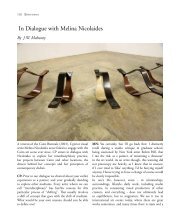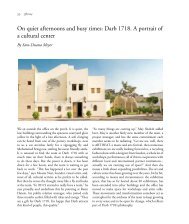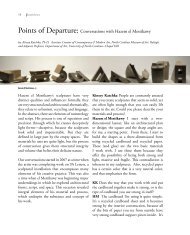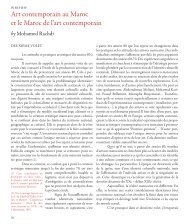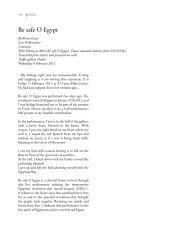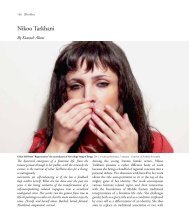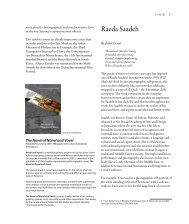full essay - Contemporary Practices
full essay - Contemporary Practices
full essay - Contemporary Practices
- No tags were found...
You also want an ePaper? Increase the reach of your titles
YUMPU automatically turns print PDFs into web optimized ePapers that Google loves.
100 EssayMohammed Naghi, Paysage (Vache dans le pré), 40x50cm., oil on board, circa 1920. Dr. Hussam Rashwan Collection, Alexandria.study as well as a smaller painting in 1928. All threedepict dervishes from the Mawlawi order performingtheir own version of the ‘zikr’, the Islamic devotional actduring which God is remembered through the repeatedrecitation of His Names. The Mawlawi dervishes’custom of the ‘zikr’ consists in a form of dance andmusical ceremony known as the ‘Sama’, which waspractised in the ritual hall called the ‘samahane’. Thedervishes usually spin on their left foot and wear a flaredand loose white gown, as a symbol of death; a wideblack cloak known as the ‘hirka’, standing for the grave;and a conical felt brown hat named ‘kûlah’ or ‘sikke’,that symbolises the tombstone. The Mawlawi dervishesbelieved that by performing the ‘Sama’, their spiritualascent through the mind and love would enable themto reach the ‘Perfect’. It is precisely this mystical journeyof the human spirit that he illustrates in these threepaintings. What strikes the viewer when first looking atthose works is the extraordinary virtuosity in replicatingthe swirling movement of the dervishes onto a twodimensional surface. The helical composition is dictatedby the dervishes’ care<strong>full</strong>y thought out positions,balanced by the direction of their opened arms and oftheir tall hats. Saïd appears to have experimented withtwo different ways of achieving the spinning effect of thedervishes’ dance. The three dervishes are very differentlystaged when comparing the watercolour with the smaller1928 panel. In the former, he tried out the compositionon a vertical format and placed the dervishes very closeto one another, to form a tight group at the centreof their rotational dance. The dervish wearing a lightred cloak in the foreground is the spin’s driving force,with his arms opened wide, almost like a propeller. Incontrast, the horizontal option for the 1928 panel offers



